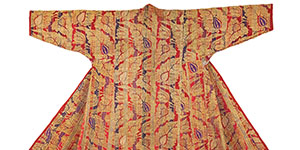
During the nineteenth and early twentieth centuries, the traditional clothing of Uzbek men, women and children was all fairly similar. Robes in general (khalats or chapans) were long and spacious with a front opening, often lined with printed fabric and commonly faced with ikat or bias-cut bekasab. There was a great variety in the quality of the fabric, which ranged from silk velvets and metallic brocades to silk, adras, ikat, bekasab, and cotton. Khorezm robes from the north of Uzbekistan were known for their machine quilting (kavik) in finely spaced vertical rows, which produced an iridescent sheen as light hit the surface of the silk and cotton striped bekasab. Kyrgyz men and young boys wore and still wear heavy, padded and quilted velvet khalats lined with printed cotton in the style of the Uzbeks and the Tajiks. Gunnar Jarring, the erudite and adventurous early 20th century Swedish linguist and diplomat, recalled his first visit to Kashgar, a city along the southern rim of the Taklamakan Desert in 1929. A book and antique dealer was eager to trade valuable manuscripts for a kilo of old Swedish newspapers, which he immediately turned over to a local tailor for use as interlinings of the quilted chapans, preventing penetration of the strong desert winds.
A unique article of Central Asian clothing is the Kyrgyz and Kazakh apron-skirt (beldemchi), most often embroidered, but also pieced. Made by the mother of the bride as part of the dowry, it was richly ornamented in wealthy families. After one year of marriage and the first child, a new bride would exchange her marriage headdress for a beldemchi, signifying her transition into the community as a mother.